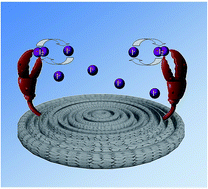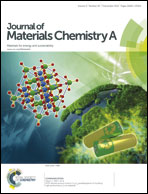Towards sustainable power sources: chitin-bound carbon electrodes for electrochemical capacitors
Abstract
Chitin – a naturally occurring biopolymer – was employed for the first time as a binder for carbon electrodes and studied in electrochemical capacitors. Chitin-bound electrodes have shown excellent performance in neutral aqueous electrolytes up to 5 A g−1 current load with a capacitance retention of ca. 80% of the initial value for mild regimes. This study reports on the electrochemical behaviour of commercially available activated carbon (Supra 30 NORIT) bound with chitin (10% wt.) in the form of pellets, operating in two different aqueous electrolytes, i.e. 1 M Li2SO4 and 1 M KI solutions. It has been found that, for the 1 M Li2SO4 solution, the carbon electrodes demonstrate a moderate capacitance value of 65 F g−1 at 1 A g−1 current density. In 1 M KI solution merging electrical double-layer capacitance and faradaic contribution of the iodide/iodine redox couple, at the same current load, the capacitance was 175 F g−1 and it significantly increased with cycling to 260 F g−1 in the case of the chitin binder, and 300 F g−1 for the PTFE-bound electrodes taking into account the total charge supplied during capacitor discharging. Moreover, for the 1 M Li2SO4 solution, the chitin-bound electrodes display slightly better charge propagation than the PTFE-bound ones, whereas for the 1 M KI solution, the energy of the capacitor has been improved by 1 W h kg−1. Considering the rather negative impact of the commonly used binding fluoropolymers on the environment, chitin may become a great alternative for the development of cheap and environmentally benign electrochemical capacitors, while preserving their mechanical and electrochemical performance. Additionally, fluorine-based (e.g. PVDF or PTFE) electrodes are more hydrophobic and thus electrolyte penetration into the bulk of electrodes is unfavoured. It is noteworthy that the formation of a chitin complex with electrochemically generated iodine, which has a tendency to leave the system, may enhance the reversibility of the iodide/iodine redox couple and improve both the capacitance value as well as the cycle life.


 Please wait while we load your content...
Please wait while we load your content...